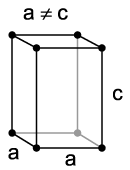Difference between revisions of "Translations:AY Honors/Rocks & Minerals - Advanced/Answer Key/39/en"
From Pathfinder Wiki
(Importing a new version from external source) |
(Importing a new version from external source) |
||
| Line 1: | Line 1: | ||
</noinclude> | </noinclude> | ||
[[Image:Tetragonal.png|thumb|200px|Tetragonal cyrstal]] | [[Image:Tetragonal.png|thumb|200px|Tetragonal cyrstal]] | ||
| − | Tetragonal crystal lattices result from stretching a cubic lattice along one of its lattice vectors, so that the cube becomes a rectangular prism with a square base (a by a) and height (c, which is different from a). | + | Tetragonal crystal lattices result from stretching a cubic lattice along one of its lattice vectors, so that the cube becomes a rectangular prism with a square base (a by a) and height (c, which is different from a). Tetragonal crystals include: |
| − | # '''Wulfenite''' is a lead molybdate mineral with the formula PbMoO<sub>4</sub>. | + | # '''Wulfenite''' is a lead molybdate mineral with the formula PbMoO<sub>4</sub>. It can be most often found as thin tabular crystals with a bright orange-red to yellow-orange color, sometimes brown, although the color can be highly variable. In its yellow form it is sometimes called "yellow lead ore". |
| − | # '''Urea''' is an organic compound of carbon, nitrogen, oxygen and hydrogen, with the formula (NH<sub>2</sub>)<sub>2</sub>CO. | + | # '''Urea''' is an organic compound of carbon, nitrogen, oxygen and hydrogen, with the formula (NH<sub>2</sub>)<sub>2</sub>CO. It was the first organic compound to be artificially synthesized from inorganic starting materials. |
# '''Zircon''' is a mineral belonging to the group of nesosilicates. Its chemical name is zirconium silicate and its corresponding chemical formula is ZrSiO<sub>4</sub>. | # '''Zircon''' is a mineral belonging to the group of nesosilicates. Its chemical name is zirconium silicate and its corresponding chemical formula is ZrSiO<sub>4</sub>. | ||
Latest revision as of 15:40, 22 April 2021
Tetragonal crystal lattices result from stretching a cubic lattice along one of its lattice vectors, so that the cube becomes a rectangular prism with a square base (a by a) and height (c, which is different from a). Tetragonal crystals include:
- Wulfenite is a lead molybdate mineral with the formula PbMoO4. It can be most often found as thin tabular crystals with a bright orange-red to yellow-orange color, sometimes brown, although the color can be highly variable. In its yellow form it is sometimes called "yellow lead ore".
- Urea is an organic compound of carbon, nitrogen, oxygen and hydrogen, with the formula (NH2)2CO. It was the first organic compound to be artificially synthesized from inorganic starting materials.
- Zircon is a mineral belonging to the group of nesosilicates. Its chemical name is zirconium silicate and its corresponding chemical formula is ZrSiO4.

